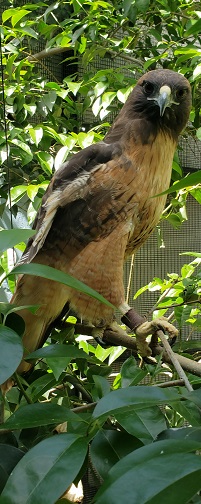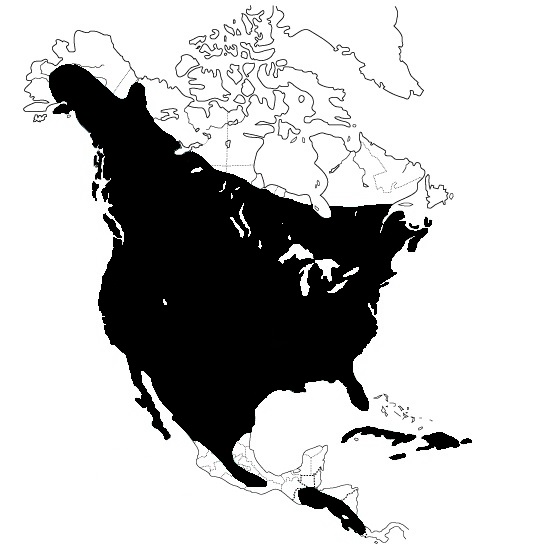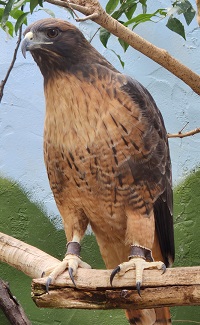Red-tailed Hawk
Buteo jamaicensis
- Habitat: Wide range which includes temperate forests, subtropical and tropical montane forests, shrubland, desert, rural fields and gardens
- Range: Canada, Mexico, United States and the Caribbean Islands
- Natural Diet: reptiles, birds and small mammals
- Status in the Wild: Common
All about the Red-tailed Hawk
Red-tailed Hawks are birds of prey that are closely related to eagles, vultures, falcons, and kites. Their plumage is mostly dark brown with breasts of light brown or creamish white. They have creamish-white down feathers on their wings and backs. The undersurface of their wings is also covered with creamish-white down feathers. Their bills are black and they have white featherless eye patches. Their reddish-brown tail feathers give them their name. Red-tailed Hawks have well-developed talons and hooked bills which help them hunt more effectively. Due to their large range distribution, their plumage colors may vary and there can be different color morphs.
Although females are similar to males in color, shape, and form, females are approximately 25% larger in size. Red-tailed Hawks are diurnal and are active by day. They have highly developed senses of hearing and sight which helps them hunt their prey. They are large birds being between two and two and a half feet in body length and a wingspan that is between three and a half to five feet wide. While females can weigh up to four pounds, males are around 3 pounds in weight.
Diet/ Habitat/ Range
Red-tailed Hawks are carnivorous and mainly feed on mammals, birds, and reptiles. They prefer to live and hunt in forested habitats although they avoid living in thickly forested areas and in very cold climates such as the tundra region. They are found in North America (Canada, USA, and Mexico), Central America (Panama, Costa Rica, Nicaragua, Honduras, El Salvador, Guatemala, and Belize), and the Caribbean Islands.
Behavior
Red-tailed Hawks from Alaska and Canada migrate south during winter. However, wild populations living in the southern portion of their distributional range either migrate short distances or do not migrate at all.
These hawks emit a range of vocalizations.
While males emit loud screeches while in flight to warn their
competitors that their territories are occupied, both males and
females emit alarm calls to alert their families to the presence of
a predator.
Red-tailed Hawks are highly territorial defending their territories
to protect their food resources and their families. While males
protect territories and food resources, females are territorial
around the nesting sites, protecting their nests and chicks. Males
exhibit specific behaviors to protect their territories which,
include aerial displays such as steep dives and up-and-down flight
movements. Aggressive posturing has also been documented where the
dominant bird holds its head and neck high, ruffling its feathers to
look larger than usual while submissive birds are seen to hold their
heads low down with smooth unruffled feathers.
Reproduction
Red-tailed Hawks select a single partner to
pair with for most of their lives only changing partners if their
mates pass away. Breeding is initiated through a sequence of
courtship displays that include flying in circles together and
preening each other. They usually build nests using bark, twigs,
pine needles, and sticks in high tree canopies that provide them
with a clear view of their surroundings. While some pairs build new
nests every year, others choose to return to their
old nests. The breeding pair work on their nests for several years
making them fairly large (around three feet in diameter and depth).
Females can lay from one to five eggs in a clutch. The eggs are incubated for a month before they hatch. Although, both males and females incubate eggs and feed their chicks (biparental care), females do it more predominantly. The males feed their partners and chicks when females are incubating eggs and chicks. The chicks fledge when they are about 2.5 months old and are able to fly. They start feeding themselves at four months and reach sexual maturity when they are about three years of age.
Conservation/Status
Since free-ranging populations of Red-tailed Hawks are estimated to be currently stable, they have been categorized as Least Concern by the International Union for World Conservation. Red-tailed Hawks are also protected by the U.S. Migratory Bird Act.


.jpg)
